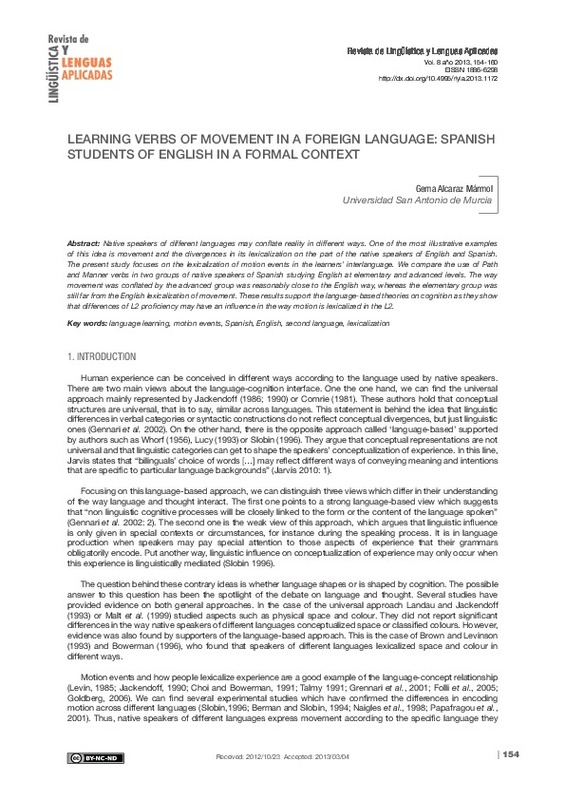Berman, R. and Slobin, D. (1994). Relating Events in Narrative: A Crosslinguistic Developmental Study. Hillsdale: Erlbaum.
Bowerman, M. (1996). "The Origins of Children's Spatial Semantic Categories: Cognitive versus Linguistic Determinants". in J. Gumperz and S. Levinson (eds.) Rethinking Linguistic Relativity. Cambridge: Cambridge University Press, 145-76.
Brown, P. and Levinson, S. (1993). " 'Uphill' and 'Downhill' in Tzeltal". Journal of Linguistic Anthropology 3/1, 46-74. http://dx.doi.org/10.1525/jlin.1993.3.1.46
[+]
Berman, R. and Slobin, D. (1994). Relating Events in Narrative: A Crosslinguistic Developmental Study. Hillsdale: Erlbaum.
Bowerman, M. (1996). "The Origins of Children's Spatial Semantic Categories: Cognitive versus Linguistic Determinants". in J. Gumperz and S. Levinson (eds.) Rethinking Linguistic Relativity. Cambridge: Cambridge University Press, 145-76.
Brown, P. and Levinson, S. (1993). " 'Uphill' and 'Downhill' in Tzeltal". Journal of Linguistic Anthropology 3/1, 46-74. http://dx.doi.org/10.1525/jlin.1993.3.1.46
Choi, S. and Bowerman, M. (1991). "Learning to express motion events in English and Korean: the in the influence of language-specific lexicalization patterns", Cognition 41/1, 83-121. Comrie, B. (1981). Language Universals and Linguistic Typology: Syntax and Morphology. Chicago: University of Chicago Press.
Folli, R and H. Harley (2005). "Flavours of v: Consuming Results in Italian and English", en P. Kempchinsky and R. Slabakova (eds.) Aspectual enquiries. Dordrecht: Springer. 95-120.
Gennari, S., Sloman, S., Malt, B. and T. Fitch. (2002). "Motion events in language and cognition". Cognition 83/1, 49-79. http://dx.doi.org/10.1016/S0010-0277(01)00166-4
Goldberg, A. (2006). Constructions at Work: The Nature of Generalization in Language. Oxford: Oxford University Press.
Jackendoff, R. (1986). Semantics and Cognition. Cambridge: MIT Press.
Jackendoff, R. (1990). Semantic Structures. Cambridge: MIT Press.
Jarvis, S. (2010). "Conceptual transfer: Crosslinguistic effects in categorization and construal". Bilingualism: Language and Cognition, 14/1, 1-8. http://dx.doi.org/10.1017/S1366728910000155
Landau, B. and Jackendoff, R. (1993). " 'What' and 'where' in spatial language and spatial cognition", Behavioral and Brain Sciences 16/2, 217-38. http://dx.doi.org/10.1017/S0140525X00029733
Levin. B. (1985). "Lexical semantics in review: An introduction". Lexical Semantics in review. Ed. B. Levin. Cambridge: MIT Press.
Lucy, J. (1993). Grammatical Categories and Cognition. Cambridge: Cambridge University Press.
Malt, B., Sloman, S., Gennari, S., Shi, M., and Y. Wang. (1999). "Knowing versus naming: similarity and the linguistic categorization of artifacts", Journal of Memory and Language 40/2, 230-62. http://dx.doi.org/10.1006/jmla.1998.2593
Naigles, L. and Terrazas, P. (1998). "Motion verb generalizations in English and Spanish: Influences of language and syntax", Psychological Science 9/2, 363-69. http://dx.doi.org/10.1111/1467-9280.00069
Navarro, S. and Nicoladis, E. (2005). "Describing motion events in adult L2 Spanish narratives", in D. Eddington (ed.) Selected Proceedings of the Sixth Conference on the Acquisition of Spanish and Portuguese as Firs and Second Languages. Somerville: Cascadilla Proceedings Project, 102-107.
Papafragou, A., Massey, C. and L. Gleitman. (2001). "Shake, rattle 'n' roll: The representation of motion in language and thought". Ms. University of Pennsylvania.
Pavlenko, A. (2005). "Bilingualism and Thought", in J. F. Kroll and A. M. B. de Groot (eds.) Handbook of Bilingualism: Psycholinguistics approaches. New York: Oxford University Press, 417-32.
Slobin, D. (1996). "Two Ways to Travel: Verbs of Motion in English and Spanish", in M. Shibitani and S. Thompson (eds.) Grammatical Constructions: Their Form and Meaning. Oxford: Oxford Clarendon Press, 195-220.
Talmy, L. (1991). Path to Realization: A Typology of Event Conflation. Berkeley: Berkeley Linguistic Society.
Whorf, B. (1956). "The Relation of Habitual Thought and Behaviour to Language", in J. Carroll (ed.) Language, thought, and reality: selected writings of Benjamin Lee Whorf. Cambridge: MIT Press, 39-58.
[-]








